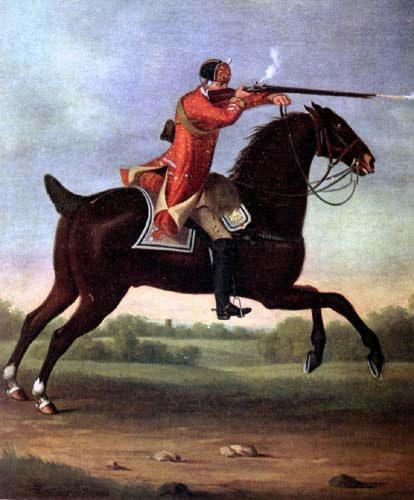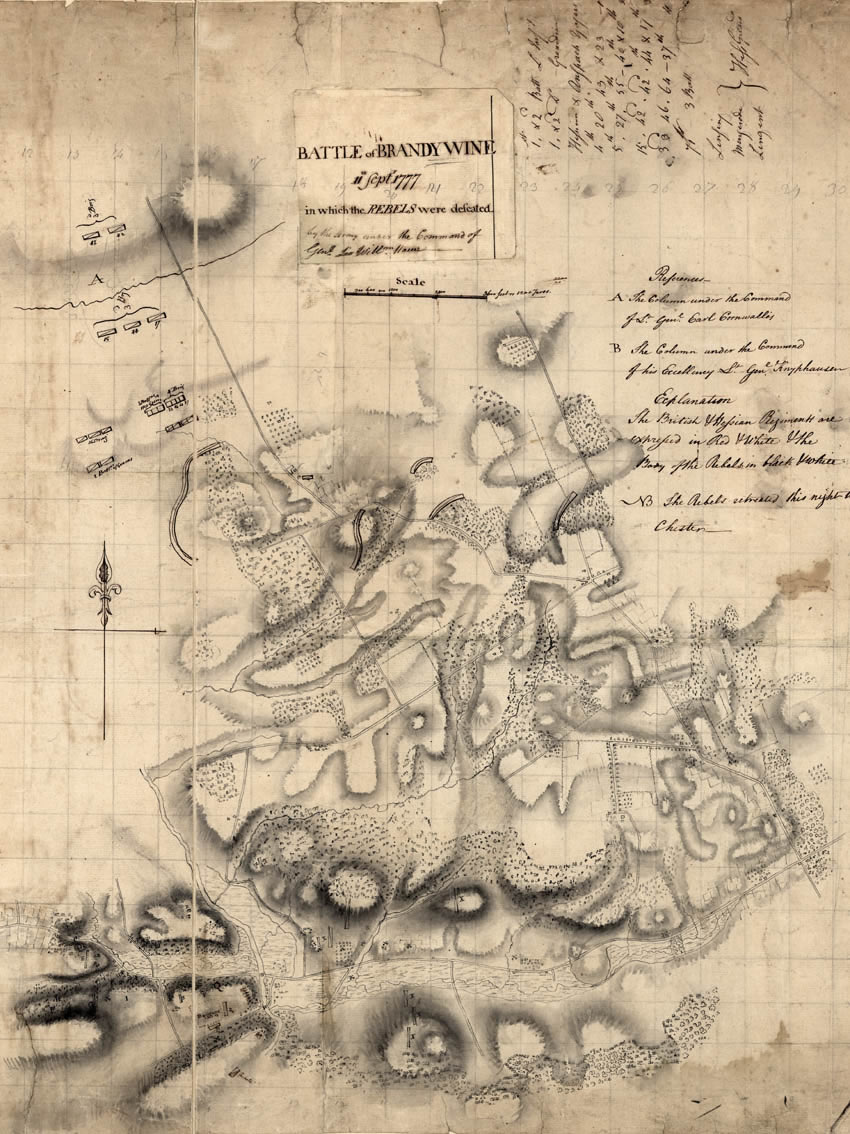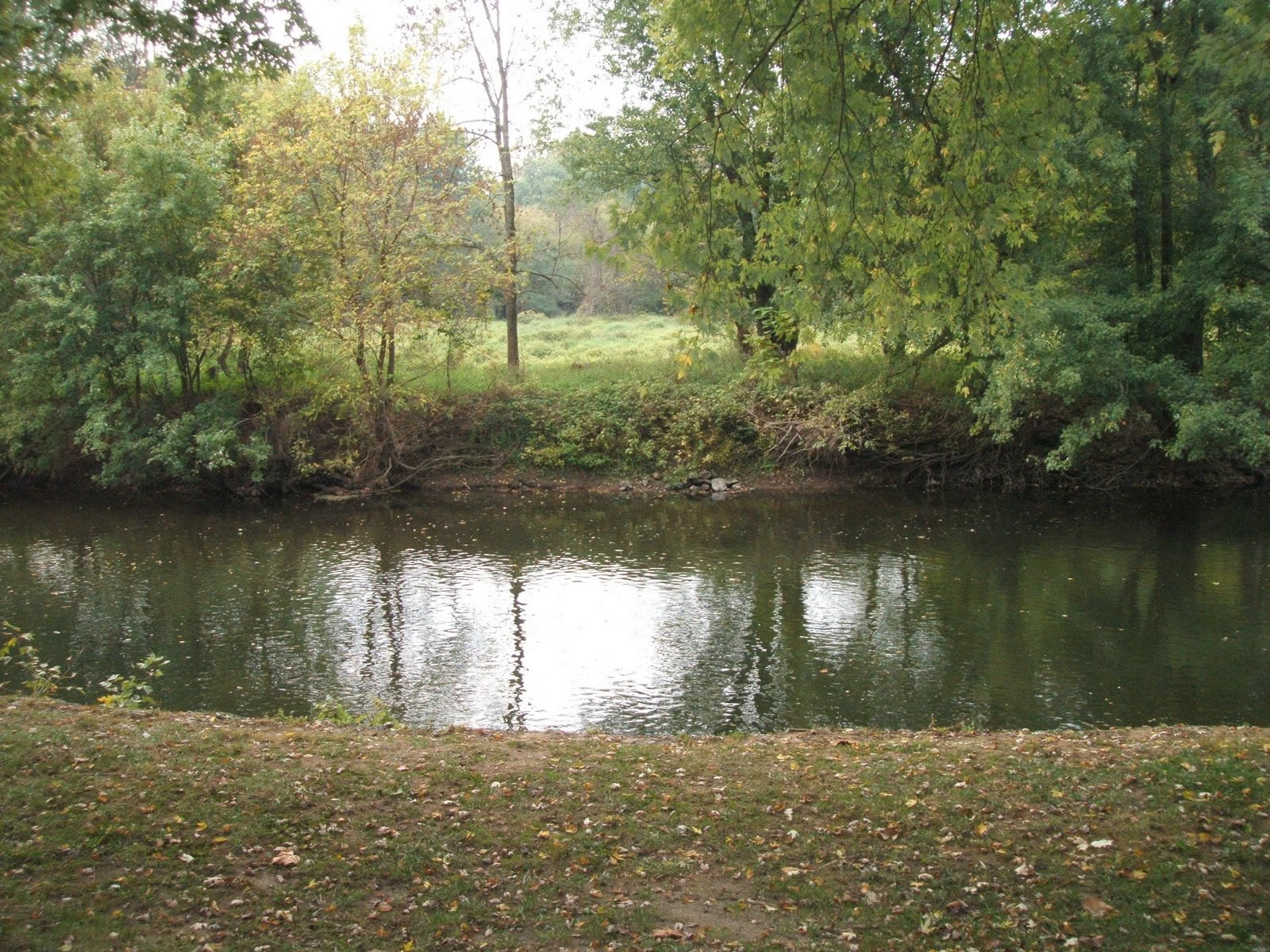
Baltimore Pike (then Nottingham Road) is the only thing that separates the Brandywine Battlefield Park from encroaching suburban sprawl. More than 300 years ago, the park's 52 acres of verdant pastures, including the Benjamin Ring House and the Gideon Gilpin House, and a section of the Brandywine River (known as a creek to locals) were witnesses to quite possibly the most influential battle of the American Revolution. The setting of the battle was then in the midst of Chester County; it now lies in Delaware County since the 1789 creation of that county. Situated at the heart of the Quaker community, the pristine countryside (ideal for raising grain and livestock) once lay in peace. On September 11, 1777, its landscape of undulating hills and wandering creeks allowed for defensive maneuvers. Thick trees shaded the movements of light infantry in open formation, along with the dense fog of the early morning on that day.
Two days earlier, the Continental Congress was notified of the intentions of General Sir William Howe, leader of the British Crown Forces, by a letter from General George Washington, commander of the Continental Army. It stated:
The enemy advanced yesterday with a seeming intention of attacking us upon our post near Newport. We waited for them the whole day; but they halted in the evening at a place called Milltown, about two miles from us. Upon reconnoitering their situation, it appeared probable that they only meant to amuse us in front, while their real intent was to march by our right, and, by suddenly passing the Brandywine and gaining the heights upon the north side of that river, get between us and Philadelphia, and cut us off from that city. To prevent this, it was judged expedient to change our position immediately. The army accordingly marched at two o’ clock this morning, and will take post this evening upon the high grounds near Chads’s Ford.
The Continental Army had received devastating blows during the failure of the previous year’s New York campaign. It was an abject group of about 13,000 soldiers, amassed only after incessant pleas from General George Washington to the states and Congress. The group was also comprised of militiamen, or untrained citizen-soldiers. They lacked American reinforcements because of disenchantment with the length of the war, news of defeats, horror stories of imprisonments, the prevalence of camp disease, as well as discontent with pay and the unfair promotions of a few. Lack of money, however, was the biggest problem. By this point in the war, infantry regiments were often given blue uniform coats, but the militia were given nothing but the permission to fight. They were not only poor in appearance, they were poor in size. Their meager appearance was juxtaposed with the noble dress of soldiers from other countries, such as French officers and other European soldiers seeking adventure in the Americas, who had aligned themselves with the cause of American independence. After hearing of Washington’s gallant victories at Trenton and Princeton, the Marquis de Lafayette, a French nobleman, insisted on volunteering for the American Army at his own expense and was appointed major-general by Congress; he would get his first taste of war with the American Continental Army. With the help of Lafayette and others, they were charged with the protection of Philadelphia at all costs, having lost New York the year before. Capturing the colonial capital would mean sudden victory for the British.
The Crown Forces were constituted of British Army regiments and troops of Hessians (German mercenaries), as well as American Loyalists (citizens loyal to the dominion of the British Crown). This armed force of 18,000 soldiers was professionally trained by their superiors, many of whom were European nobility. They had come from the British fleet of 267 ships, under British Commander-in-Chief General Sir William Howe. Having set sail a few months earlier along the Delaware Bay, much of their food had been spoiled. They had survived in a foreign country by raping the towns they encountered of their food and supplies. Cattle and other livestock were ransacked for food; horses for war. Despite having to live like petty criminals, they dressed in red coats and bearskin caps, leather caps, or tricorner caps, whether they were grenadiers, light infantry, or battalion company men. The 16th and 17th regiments of light dragoons wore red coats and leather-lined helmets. The German infantry retained the Prussian style grenadier mitre (headdress) with a brass front plate and wore blue coats. They were well-dressed and well-trained.
While traveling along the Delaware River, Howe received word that their path was blocked by a small American naval force’s fortifications, so he changed their course to the Chesapeake Bay with a destination of Elk Ferry, some 30 miles southwest of Philadelphia. At the same time, Washington and his men, who had been in the Watchung Mountains near Morristown, New Jersey since their victory at the Battle of Princeton, marched south to Wilmington, Delaware. They arrived on the August 25, the same day Howe landed at Elk Ferry. Landing without opposition, Howe used this time to let his tired, seasick men recover from their journey while Loyalists replenished their supplies. On September 3, the army started marching toward Philadelphia, one division commanded by Lt. Gen. Wilhelm Knyphausen and the other by Major General Charles Cornwallis. For the next five days, Washington positioned his men traveling along the White Clay Creek, west of Newport and Wilmington. He expected Howe to lead his men toward Wilmington, but Howe refused to fall into the trap of Washington’s advantageous ground. He made Washington change his defensive ground by making a feint north towards Pennsylvania, moving them to the Brandywine River at Chads’ Ford (now Chadds Ford). This game of cat and mouse was futile because Philadelphia was known to be Howe’s ultimate goal. The outcome of this battle would allow one side to properly defend the capital or the other to take it, and in doing so the fate of the Revolution would be determined. The battle itself garnered the largest movement of troops during the revolution, a reported 26,000 men.
Washington stationed his troops along the main fords on the eastern side of Brandywine Creek on the morning of September 9, in order to force a fight at Chads’ Ford between Chester County and Philadelphia. Conflicting reports came to Washington, claiming that Howe’s troops would make a frontal attack at Chads’ Ford. Therefore, General Washington stationed the center of his troops at the 150 foot-wide ford on the north side of the Brandywine. The ford, a crossing shallow yet sturdy enough to allow horses and wagons to travel over, was blocked to stop the British from traveling along the road north to Philadelphia. On the eve of the great battle,Washington continued to receive conflicting information about the whereabouts of the British Army. He and Lafayette spent the night in Benjamin Ring’s house and Gideon Gilpin’s house, respectively, log cabins on the shore of the Brandywine River, remnants of Swedish and Finnish settlers from the 1630s, which remain part of the park.
The dawn of September 11, 1777 saw the British forces begin the six-mile march from Kennett Square northeast to Chads’ Ford at 5am. Howe’s strategy, which he first used at Bunker (or Breed’s) Hill in Boston in 1775 and at the Battle of Long Island in 1776 with a disastrous outcome for the Americans, was to give the impression the attack was a frontal assault to draw the American flank out and then send troops around the flank to cause them to retreat, shift position, or be surrounded. Typical early-morning weather of fog and haze shrouded the area. The first to leave was a 496-member vanguard which consisted of Queen’s Rangers, Ferguson’s riflemen, and a squad from the 16th Light Dragoons, followed by the 1st and 2nd British Brigades, the artillery, supply wagons, and a herd of rustled livestock. Serving as the rear guard was the 71st regiment. The battle also marked the debut of a military innovation, the Ferguson breech-loading (loaded from the back) rifle on the battlefield. Used by Ferguson’s Corps of English Riflemen, “It was a short, carbine-style firearm that could be loaded and fired up to six times to per minute –twice the rate of a smoothbore musket—and it was rifled, giving it great accuracy at two hundred yards,” according to noted Brandywine historian Thomas J. McGuire. Smoothbore military muskets, or firelocks, were used by both sides. Eighteen inches of steel, triangular at the base tapering into a sharp point, struck fear into enemies faster than the bayonet itself could enter their bodies.
Lt. Gen. Wilhelm von Knyphausen, a Hessian officer, led a division 7,000 troops with the purpose of distracting Washington on the south side by marching east on Nottingham Road (now Baltimore Pike). The fog covered some of the British troops’ movements, but they were eventually seen by American scouts. While this occurred, Major General Charles Cornwallis, commander of the light infantry, led the division of 8,000 men in a circuitous route along the western side of the Brandywine. They had crossed the river by mid-afternoon at the unguarded Trimble’s Ford on the western branch. Then, after crossing Jeffries’ Ford on the eastern bank, they gained a strategic position to the north of Washington’s troops and settled near the Birmingham Friends Meeting House. Strategically, Knyphausen was ordered to simply occupy the area overlooking the Brandywine and not to attack unless provoked, so that he could be alerted by the gunfire from Cornwallis’ troops behind the American army to attack. Washington had assumed the attack would be on the Brandywine at Chads’ Ford, and Howe took full advantage of that assumption.
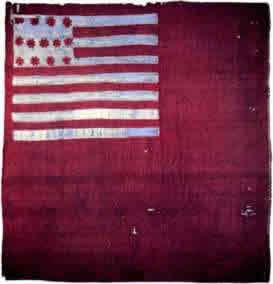
Although Washington continued to believe that the main force was moving to attack at Chads’ Ford, his hesitance to act on any of the reports, especially one of the local’s reports, would prove costly. Washington stationed his troops along the eastern side of the Brandywine near Chads’ Ford. Chads’ Ferry, 500 yards south of Chads’ Ford, was guarded by Gen. Nathanael Greene’s division of 1800 Virginia Continentals. He was positioned to provide support for the center of Washington’s troops. To Greene’s right, Gen. Anthony Wayne’s Division of Pennsylvanian Continentals protected the ford itself with 1600 strong. About a mile north of Chads’ Ford, Generals John Sullivan, Adam Stephen, and William Alexander (a.k.a. Lord Stirling) and their men were stationed by the Birmingham Meeting House. Unfortunately, local Loyalists informed Howe of Washington’s position, as well as his undefended fords.
When the local Quakers realized the British army’s surprise attack, a twenty year old noted, “...In a few minutes the fields were literally covered with them...Their arms and bayonets being raised shone as bright as silver, there being a clear sky and the day exceedingly warm.” It was 4pm when the British attacked. Howe was slow to attack the American troops, which gave them time to position some of their men to receive the British threat to their right flank. Stephen’s and Stirling’s divisions received the brunt of the assault, and both lost ground fast. Sullivan attacked a group of Hessian troops trying to outflank Stirling’s men near Meeting House Hill and bought some time for most of Stirling’s men to withdraw, but British fire forced Sullivan’s men to retreat.
By 4:30pm, Knyphausen’s artillery opened fire. His men, on the west bank of the Brandywine, attacked General William Maxwell’s and General Wayne’s American divisions as they crossed Chads’ Ford. Soon, they had reached the Chester County side of the Brandywine. Maxwell and Wayne’s divisions were forced to retreat and leave behind most of their cannon. General John Armstrong’s militia, never engaged in the fighting, also retreated from its positions. Further north, Greene sent Colonel Weedon’s troops to cover the road just outside the town of Dilworth (now Dilworthtown) to hold off the British long enough for the rest of the Continental Army to retreat. At this point, Washington and Greene arrived with reinforcements, having traveled the mile north, to try to hold off the British, who now occupied Meeting House Hill. The remnants of Sullivan’s, Stephen’s, and Stirling’s divisions, fewer than 3,000 American troops, stopped the pursuing British for nearly an hour. Five times the British drove Americans from the hill; five times it was retaken. Finally, only when Cornwallis invoked the full power of his entire artillery did he successfully cause them to retreat east toward Dilworth.
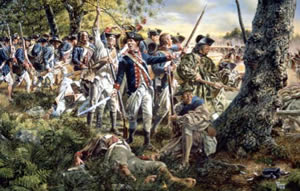
An hour and forty-five minutes after the battle had begun, it had ended. British Captain John André, the infamous British spy later tried and hanged for his treason with Benedict Arnold, noted in his journal, “Night and the fatigue the soldiers had undergone prevented any pursuit.” If they had pursued the American army, there would not have been a battle at Germantown. With the British no longer attacking, Weedon’s force was left to retreat. The defeated Americans marched to Chester, where most of them arrived at midnight with some stragglers arriving until morning, north to the Falls of the Schuylkill, a day’s march from Germantown. At midnight, George Washington wrote from Chester to the Continental Congress, “Sir: I am sorry to inform you, that in this day’s engagement, we have been obliged to leave the enemy masters of the field.”
The Battle of Brandywine was the only time arguably the greatest British general and the greatest American general met in combat. Both men made egregious errors; Washington incompetently left his right flank wide open, which could have caused countless unnecessary American losses had it not been for the cavalry of Sullivan, Sterling, and Stephen’s divisions, and Howe failed to attack the American right flank quickly and destroy the American army when he was given the chance. Howe’s failure to attack the American right flank quickly showed his indecision as a leader, which allowed most of the American army to escape.
Official casualty figures vary. Both sides and their counts were biased. Historian Thomas J. McGuire states that, “American estimates of British losses run as high as 2,000, based on distant observation and sketchy, unreliable reports.” 587 British casualties have been listed: 93 killed, 488 wounded, and 6 missing or unaccounted for. Hessians only suffered a loss of 40. Most accounts of American losses were only from the British side because casualty return for American losses did not survive or were never released, official or otherwise. One initial report by a British officer recorded American casualties at over 200 killed, around 750 wounded, and 400 unwounded prisoners taken. General Howe’s report to Lord Germain, the British Secretary of War, stated that Americans “had about 300 men killed, 600 wounded, and near 400 made prisoners.” One of the very few figures of casualties from the American side was reported from Major-General Nathanael Greene, whose count was between 1,200 and 1,300 men. Taking Greene’s numbers into account, the estimate of the total American loss was between 1,160 and 1,260 Americans killed or wounded in the battle. Regardless of the number of casualties, this battle left an everlasting impression on American history.
The Continental Army did not see their loss as a discouragement. Instead, they used the victory of the British at the Battle of Brandywine and the ensuing Battle of Paoli to their advantage. The unsuspecting British never thought that the Continental Army would regroup and attack the British encampment at Germantown, which they did. The attack was officially a loss for Washington and his men, but it was a moral victory, reaffirming their hope, and engendering the support of the Comte de Vergennes, the French Foreign Minister, and his government to work with them against the British. “[T]he genius and audacity shown by Washington, in thus planning and so nearly accomplishing the ruin of the British army only three weeks after the defeat at the Brandywine, produced a profound impression upon military critics in Europe,” wrote John Friske in 1891 in his book The American Revolution. For the next six months, Washington and his troops camped and trained in the hills Valley Forge throughout the dead of winter. Despite causalities of nature, the Continental Army once again attacked the British and regained control of Philadelphia.
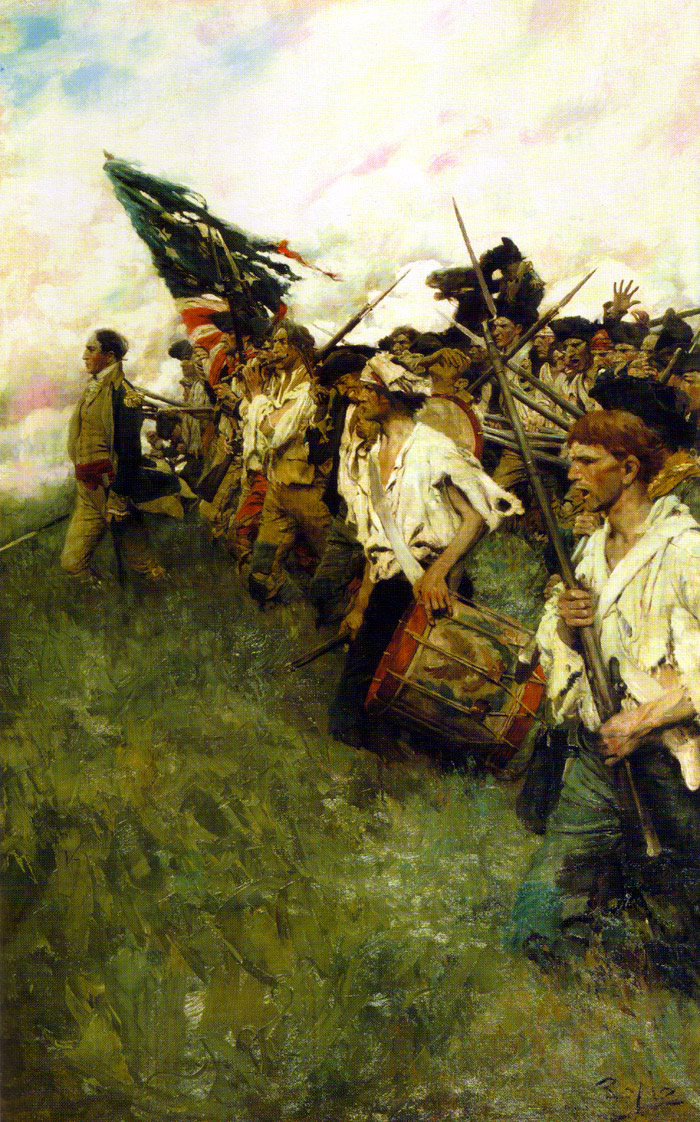
In later days, Howard Pyle (1853-1911), “The Father of American Illustration,” inspired by the Continental Army’s heroism against insurmountable odds, preserved their bedraggled bravery in a painting, “The Nation Makers,” in 1903. It was the culmination of painting with his students for five summers at Chadds Ford. Unknowingly, he established the so-called “Brandywine School” by providing inspiration for some of America’s most outstanding illustration art, which can be seen through the works of his proteges, Frank Schoonover, Stanley Arthurs, N.C. Wyeth, W.J. Aylward, Thorton Oakley, Violet Oakley, Clifford Ashley, and Harvey Dunn.
More recently, others have tried to preserve Brandywine River’s surrounding “storied vales and hills,” the 52 acres around Chadds Ford, which became a Pennsylvania State Park in 1949 and was recognized as a National Historic Landmark on January 20, 1961 on the National Register of Historic Places as Brandywine Battlefield Park. Since then, the park has been protected from the advancements of technology, sustained by the staff’s vigor for reenactments. Brandywine Battlefield Associates portray everything from Quaker farmers to British and Continental soldiers during special events the park hosts throughout the the year. They also guide daily tours of the park and battlefield. Their mission is “to present educational programs, exhibits, tours, events and publications that broaden public understanding and appreciation of the significance of the Battle of Brandywine within the larger social, political, economic, technological and military context of the American Revolution period.” On August 14, 2009, the park closed its gates, along with three other PHMC (Pennsylvania Historical & Museum Commission) museums, because of insufficient funding in the state’s ongoing budget crisis. The Historic Site reopened on August 25th, 2009, thanks to an interim agreement between PHMC and Chadds Ford Township with the Brandywine Battlefield Associates. The park is operated with limited staff and volunteers, who believe it is their duty to “take lead responsibility for [the] interpretation of, and participate in efforts to preserve, the entire Battlefield National Historic Landmark, of which Brandywine Battlefield Park is only a small part, recognizing the significance of these ten square miles where approximately 26,000 men fought.”
For this reason - among many others - Thomas Buchanan Read (1822-1872) romanticized the Brandywine River as a “winding silver line through Chester’s storied vales and hills,” in his 1845 novel, Paul Redding: A Tale of the Brandywine. The history of Chadds Ford is just a fraction of the secrets hiding behind a shade of a blade of grass or between a rock and the reddish-clay dirt. Though much of the scenery in the Brandywine Valley has changed since the time of the Battle and even from the time of Read’s writing, visitors to the town of Chadds Ford can still hear the echoes of Washington and his beleaguered army. Even more importantly, they can see the re-enactments of the tales of the “storied vales” that shaped the American Revolution.
For schedules of events and other information on visiting Brandywine Battlefield Park, please visit http://www.thebrandywine.com/attractions/battle.html.
Sources:
- “A Summer Idyll: Landscapes from the Brandywine Valley.” Brandywine River Museum. 2002. <http://www.tfaoi.com/aa/3aa/3aa320.htm>.
- Beyond Philadelphia: The American Revolution in the Pennsylvania Hinterland. Eds. John B. Frantz and William Pencak. University Park: The Pennsylvania State UP, 1998.
- Boatner, Mark Mayo. Cassell’s Biographical Dictionary of the American War of Independence, 1763-1783. London: Cassell, 1966. page 109.McGuire, Thomas J. Brandywine Battlefield: “Brandywine Battlefield Mission Statement.” Brandywine Battlefield Associates.
- Fiske, John. The American Revolution. Boston: Houghton Mifflin Company, 1891. page 332.
- “George Washington to Continental Congress, September 11, 1777.” American Memory. Ed. John C. Fitzpatrick.
- “History.” Birmingham Monthly Meeting of the Religious Society of Friends. <http://www.birminghamfriends.org/history.html>.
- “History of the Battle of Bradywine.” Brandywine Battlefield Historic Park. 1995. 4 July 1995. <http://www.ushistory.org/Brandywine/thestory.htm>.
- Jackson, John W. With the British Army in Philadelphia 1777-1778. San Rafael, CA: Presidio Press, 1979.
- MacElree, Wilmer W. “The Battle at The Ford.” Along the Western Brandywine. 2nd Ed. West Chester, PA : F.S. Hickman (printer), 1912.
- McGuire, Thomas J. The Philadelphia Campaign: Volume 1: Brandywine and the Fall of Philadelphia. Mechanicsburg, PA: Stackpole Books, 2006. page 269.
- Patterson, Richard. “What Was A Hessian?” Washington Crossing Historic Park. 11 Dec. 2008. <http://www.ushistory.org/WashingtonCrossing/history/hessian.htm>.
- Pennsylvania Trail of History Guide. Mechanicsburg, PA: Stackpole Books, 2001.
- Read, Thomas Buchanan. Paul Redding: A Tale of the Brandywine. Boston : A. Tompkins & B. B. Mussey : Redding & Co., 1845.
- Rujumba, Karamagi. “Fort Pitt Museum, Bushy Run close due to state budget crisis”. Pittsburgh Post-Gazette.14 Aug. 2009. <http://www.post-gazette.com/pg/09226/990898-100.stm>.
- Smith, Karen A. “Battle of Brandywine: A Brief Summary.” History Online. 9 Dec. 2008.
- Smith, Samuel S. “The Battle of Brandywine.” The American Revolution. 1976.
- “The Battle of Brandywine: September 11, 1777 at Brandywine, Pennsylvania.” The American Revolutionary War. 2009. <http://www.revolutionarywar.n2genealogy.com/battles/770911.html>.
- “War Comes to Revolutionary Pennsylvania.” Pennsylvania: A History of the Commonwealth. Eds. Randall M. Miller & William Pencak. University Park: The Pennsylvania State UP, 2002.

